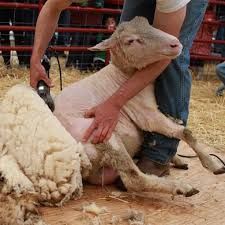
Shearing is the act of harvesting wool fleece from a sheep. The wool fibre is a hardened protein and does not contain any sensory structures. This is generally done in the spring when the sheep no longer need their winter coat.
Annual shearing benefits both the sheep as well as us humans. Shearing in the spring allows the sheep to begin growing their wool in time to have a full coat by winter. Without shearing, the animal may potentially suffer from excessive wool growth.
Too much wool may result in manure or faeces accumulating on the wool and encouraging fly egg development. The resulting fly larvae can cause serious harm to the animal and potentially death through infection. Additionally, too much wool can contribute to heat stress in warmer climates.
Length
A very important component of production. Length of wool results in more distance (length) to spin.
Density
Also determines production. Density: Amount of fibres per skin area. The balance between length and density is important. Too dense retards length, too little, the wool becomes loose and watery and thus clean yield becomes a problem.
Fineness
Wool testing below 19 micron falls into a speciality group and therefore fineness is an important economic factor.
Quality
This is the uniformity of wool over the body or fleece of the sheep — the depth of crimp, the kindness of handle and the absence of foreign fibres such as Kemp and hair. The buyer also recognizes quality as good and healthy growth (tensile strength)
Staple, Bulkiness and Tip
Staple — is the number of fibbers per surface skin area and it protects the fibre.
Bulk - is also a combination of the number of fibbers per skin surface. Wool feels bulkier in shorter than in longer wool.
Tip - The amount of yolk will determine how the tip will look or appear. Frequently a black tarry tip points to loose, watery wool. Every fibre brings its yolk to the tip. This is not very desirable because buyers cannot determine whether all the yolk will wash out. Sometimes it results in a yellow colour after the washing process.
Yolk and Colour
The wool buyer looks for white wool with a light fluid yolk. In practice, the same applies. Heavy yellow yolk results in problems with management, because the wool on the sheep does not dry quickly after rain and it then becomes a paradise for external parasites such as blowfly and lumpy wool.
Belly and Points
The ideal is a good covering on the belly and points. This area constitutes approximately 30% of the fibre, bearing area. Be aware of over-development which ensures good underlines, but results in other problems such as the wrong type of sheep and lower fertility.
NB: Maintain a balance between conformation and wool.
Determine Your Goals
- Body mass 55 kg meat production per hectare.
- 100% weaning percentage meat production per hectare.
- Wool production/big ewe 4.5 — 5 kg lambs included.
- Wool production per hectare lams included.
- Fineness below 19 microns, lambs included.
Click here to view a video that explains wool handling.